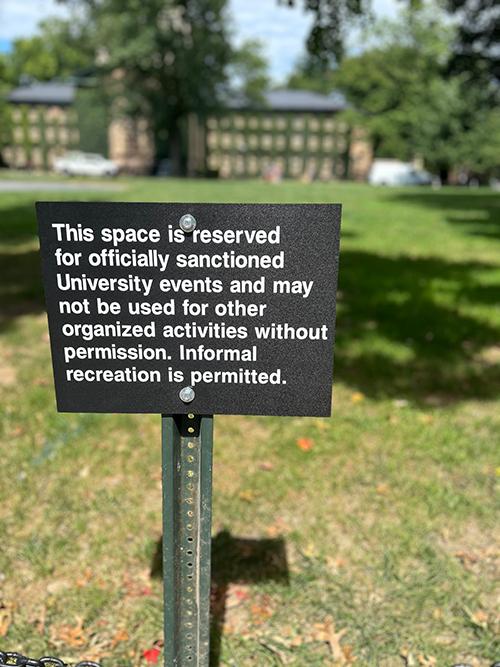
Princeton Israeli Apartheid Divest (PIAD) returned this fall semester with an inaugural rally and a familiar message from last spring, calling for the University to divest and disassociate from Israel and Israeli companies, universities, and cultural institutions, and asking Princeton to drop charges against students who participated in an April sit-in.
Before the start of the school year and in anticipation of continued protests, the University created a new website addressing guidelines and regulations for demonstrations on campus. The website was promoted to first-year students at an orientation event about free speech hosted by Vice President Rochelle Calhoun and University President Christopher Eisgruber ’83.
“If you want to protest, and protest ... in ways even that may seem outlandish to people on the other side, there are ways to do that,” Eisgruber said. “But there are also many rules that are there to make sure that the activity and functions of the University continue … .”

The Sept. 3 rally began in the courtyard outside McCosh Hall, as a throwback to where protesters first established a sit-in, known as the “Gaza Solidarity Encampment,” on April 25, and included stops at Clio Hall and the front steps of Nassau Hall.
But when the PIAD supporters marched to the front of Nassau Hall, quite a few demonstrators stood on the forbidden lawn. Despite the presence of about 10 Public Safety officers and personnel around the protest, PAW did not see any instances of demonstrators being approached by law enforcement. On Sept. 6, The Daily Princetonian reported that the University reversed its decision to ban protests in front of Nassau Hall.
“The walkways in front of Nassau Hall have long been an approved protest site,” University spokesperson Jennifer Morrill told PAW in an email. “Historically, we have recognized — and we continue to recognize — that protests legitimately spill onto the lawn. We have changed our language to reflect that.”
During the McCosh rally, counterprotesters stood at the back of the protest itself, separated from the PIAD with movable barricades. Some held flags and others had posters with the face of Hersh Goldberg-Polin, an American Israeli who was taken hostage by Hamas on Oct. 7 and killed by the group a few days before the protest.
Emanuelle Sippy ’25, president of the Alliance for Jewish Progressives (AJP), addressed the counterprotesters when she spoke, saying she had eaten at the house of Goldberg-Polin’s cousin.
She encouraged the crowd to “grieve all that there is to grieve between the river and the sea,” referring to the deaths of Israelis as a result of Oct. 7 as well as the thousands of Palestinians killed in Gaza since the beginning of the conflict.
When the protest moved from McCosh to the steps of Clio, the procession appeared to number about 150. Several PIAD members gave accounts of the sit-in at Clio Hall that took place April 29.
PIAD has maintained that the occupation of Clio that day was peaceful, but University employees and statements from administrators characterized the incident differently, especially once Princeton personnel exited the building and encountered the crowd outside.
Looking ahead, speakers at Nassau Hall called on the campus community to support students who are facing trespassing charges related to the sit-in at Clio and the pitching of tents during the original set-up of the “Gaza Solidarity Encampment.” The students are due in court on Tuesday, Sept. 10. Speakers also announced a National SJP Day of Action scheduled for Thursday, Sept. 12.
“We will keep pushing every single way we can,” said Aditi Rao, a graduate student and PIAD organizer.
This story has been changed to reflect that the protest was organized by Princeton Israeli Apartheid Divest.
